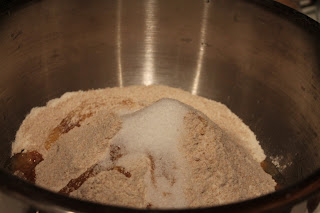 |
| Boule |
One of the bread recipes that I use for experimentation is Wild Yeast's
Norwich-More Sourdough. It's a wonderfully easy recipe, once I realized a few things (such as that it requires 20-35 minutes under steam rather than the 8 in the recipe and, in my oven at least, it needs a higher oven temperature), things actually work out fairly well. Usually, I just post modifications, but today because the bread is
so good and is quite different from the recipe.
 |
| Crust and Crumb |
Amarnath Wheat Sourdough
Ingredients
- 480g of sourdough starter 100% hydration (I used about 75% white starter and 25% whole wheat starter) May I suggest using some fairly lively sourdough starter. Mine was about 50-50 of starter from the refrigerator and starter that had been newly refreshed a few hours before.
- 500g white whole wheat starter
- 175g bread flour I ended up using bleached because I bought it by accident but, as always, I suggest unbleached
- 150g barley flour This gives a lovely sweetness to the crust. Delicious, seriously.
- 130g red whole wheat flour
- 610g + 50g water around 75 degrees F (total 660g)
- 50g Amarnath (the seeds, not flour)
- 23g salt
Directions
Day 1:
- Mix the sourdough starter, flours, and 610g water in a bowl. Mix until it forms a homogenous dough.
 |
| Dough |
- Let the bowl sit for a 30 minute autolyse period under plastic wrap or similar.
- Then mix in the amarnath, salt, and water. Mix a little and then let it sit for 5-10 minutes to allow the bread to soak up the water.
- Knead the bread for 2-3 minutes. Then do a stretch-and-fold.
- Wait 10 minutes and do another stretch-and-fold.
- Wait 10 minutes and do another stretch-and-fold.
- Wait 10 minutes and do another stretch-and-fold. (so 4 times total)
- Cover the bowl for 45 minutes (at around 75 degrees F) and do another stretch-and-fold.
- Cover the bowl for 45 minutes (at around 75 degrees F) and do a final stretch-and-fold (2 times total)
- Cover the bowl for 20 minutes (at around 75 degrees F) to finish the bulk fermentation.
- Turn the dough onto a lightly floured surface and divide into 3 medium loaves or 2 quite large loaves.
- Preshape the balls lightly into round.
- Bench rest for 20 minutes. Cover them with something. If you live in a dry climate, make sure to cover them in an airtight fashion-- I usually turn large bowls over them. While they are resting, flour bannetons or similar shaping devices for the final proofing.
- Then shape the loaves into your desired shape and place them into bannetons.
- They need to proof for 1 hour and 45 minutes before they are placed in the refrigerator overnight.
- Make sure they go into the refrigerator for 16 hours or less.
Day 2:
- Preheat the oven to 475 degrees F about 30 minutes before you take the dough out of the refrigerator.
- Take them out of the refrigerator, score them, and immediately place them into the oven under steam.
- After 20-35 minutes under steam (depending upon how tightly the steam container closes. I would suggest trying about 25 minutes. It is done when it begins to be golden and the tips of the score marks are beginning to be brown.
 |
| Golden with a hint of brown on the tips of the score marks. |
- Cook for another 10-15 minutes or until the crust is a rich brown and the internal temperature reaches 210 degrees F.
- Cool for 45 minutes before eating.
 |
| Bread with Brie (it also goes well with almond butter) |
Flavor Notes: I totally forgot (until a comment reminded me) that I hadn't talked about the flavor of this bread. it is absolutely delicious. It's wheaty (from the white whole wheat), but it doesn't have that usual bitterness that I associate with white whole wheat. Instead it's got this warm, complex, nutty richness too it (which I believe comes from the amarnath) and a hint of sweetness (from the barley). Five stars.
While I share with you the wonderful success I had today, I should also explain two things that went wrong (although they didn't keep it from being a success).
First, a small mistake, I messed up the autolyse period (I extended it it an hour because I wasn't paying attention). As such, when I mixed in the salt, water and amarneth, I messed up the gluten structure. Being a reasonably practiced at breadmaking, I was able to manipulate the dough in such a way that I got the gluten structure back together (mostly), but the crumb was still a lot tighter than it should have been.
 |
| Tight Crumb |
However, the crumb did have a wonderful gelatinized structure and it was moist and delicious.
 |
| Cool picture of the crumb |
I highly suggest making this bread and the crumb structure will be a lot better if you don't make mistakes :)
Second, I messed up on the shaping of the two batards. At first, I thought that I had underproofed the dough, but I quickly realized that I had not when the boule came out fine. This is what happens when you don't shape a batard well. Seriously, I need lessons. Advice anyone?
 |
| Comparison of the two loaves |
Even the less pretty one will taste delicious.
Tasting Note 02/18/13: This bread makes some of the best toast that I have ever tasted. Toasting brings out the barley sweetness of the bread creating an amazing depth of flavor with the warm wheaty taste. Seriously delicious. You will not regret making this bread, I promise. I'm so excited that I have two more loaves of this in my freezer!
I am submitting this to
Yeast Spotting.








































